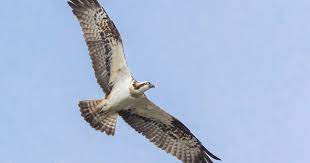
A young osprey which was tagged in Scotland last summer has been spotted over 4,000 miles away, soaking up the sun in Barbados. The female bird of prey turned up in Bawdens Irrigation Pond in the north of the Caribbean island earlier this month, having been one of two chicks ringed by the Clyde Ringing Group at a nest in Clyde Muirshiel Regional Park, Lochwinnoch, on 23 June last year.
Most ospreys normally migrate to the African continent and experts believe this is the first time a UK osprey has been observed in the Americas. The fact that the bird’s route is thought to have been from the south-west of Ireland all the way across the Atlantic, which is approximately 3,800 miles with no obvious calling point, is the part that has startled the practised observers.
Conservation group confirm mileage
The Roy Dennis Wildlife Foundation said the distance covered during the osprey’s amazing transatlantic flight was 4,124 miles. The foundation which was established in 1995, is a non-membership charitable trust dedicated to wildlife conservation in Scotland.
Nature conservationist and writer Tim Mackrill confirmed that ospreys had been colour-ringed in the UK ever since the late sixties. He said that around August and September are the months when the birds will usually start their long journeys south for a winter in warmer climates.
Disbelief at bird making it to Caribbean
Mr Mackrill confirmed that over the years they have received re-sightings on the Canary Islands, and as far south as West African countries such as: Senegal, the Gambia, Ghana and the Ivory Coast. He emphasised that these flights are treacherous and around 60% of the birds don’t make it.
Therefore, when they were contacted by conservationist Michael St John, who photographed a female with a blue ring on its left leg, with the ring number clearly visible and showing KW0, which was definitely one of the two Scottish chicks, and then he confirmed that his location was Barbados, they could barely believe it.
Hitched a ride
He said that this recording had provided them with a wealth of valuable data on everything from longevity to migratory movements. Mr Mackrill said it would be highly unlikely that the osprey, even allowing for strong tailwinds, could have completed the flight without stopping at least once.
He said it was more likely that the bird took the opportunity to rest on boats, which may themselves have been travelling to the Caribbean from the UK, possibly hopping on and off along the way. He also put forward the possibility that the osprey might have ventured off to the the Azores for a stop-off before continuing on to Barbados.
The “Tourist” bird
He was nevertheless incredibly impressed with the health of the bird: “One thing we can be certain of is that KW0 must have departed on her migration in exceptional condition in order to have survived this remarkable crossing,” he commented.
From photographs and reports from Mr St John, the intrepid traveller seems “very settled” in her adopted surroundings according to Mr Mackrill, and as a consequence he believed that there was every possibility that she may well opt to remain on the island for the foreseeable future.
RSPB pleased with sighting
The head of species at Scotland’s RSPB, Duncan Orr-Ewing was delighted to hear about the re-sighting and proud that his organisation had played a part in the encouragement of the osprey’s return as a breeding bird to the Scottish Highlands back in the fifties, after an absence of around forty years. “We are gradually seeing this species re-occupying all of its former range right across the UK, following our pioneering role many years ago, and although the osprey never cease to amaze us with their incredible exploits, this latest sighting in Barbados is certainly one of the best yet.”
Ospreys thriving in Scotland
The species did appear to have abandoned the UK shores for breeding way back in 1916, at a time when they were considered to be extinct in the country after an extended period without any sightings, with a mixture of loss of habitat and hunting taking the blame. It was not until 1954 until the next recording of ospreys breeding in the UK was recorded at Loch Garten, up near Aviemore, in the Scottish Highlands.
The general feeling was that those birds had arrived from somewhere in Scandinavia and settled naturally, rather than being reintroduced; but they have thrived over the decades since then. Indeed, they are now regarded as one of the country’s great wildlife revival stories with an estimated 250 pairs returning regularly to breed.
Defined roles for osprey parents
The osprey parents each seem to have their own specific roles in the raising of the young chicks. During the Scottish summer the males gradually increase the amount of food brought back to the nest, and when in the UK their diet is exclusively fish, with probably an average of five or six being returned on a daily basis, throughout the nesting period.
The adult birds have large and powerful talons and the underside of their feet are covered in little spines which helps keep a hold of their catch on their return to the nest. The female then tears up the fish and feeds the smaller pieces to the chicks, and continue to do so even after they have fledged.
Fish and chicks
After around ten days the female begins to leave them for extended periods until they reach maybe one month old. The health of these chicks is totally dependent upon the quantity of fish that the male is able to provide, so his role is crucial otherwise not all of the young will survive. Once they are well-feathered the female will guard them from a distance, usually a relatively close perch.
Females in a hurry to migrate
The chicks are almost fully grown and ready to fly when they reach somewhere between six and eight weeks old and surprisingly the female will leave the young and set off on its own migration, usually to Africa, but the male continues to supply fish right up to the point that all of the chicks have departed, before setting of on his own journey to a warmer continent.
Perilous journey begins at still young age
At around 12 weeks old and with no extended flying experience, and unreliable strength, these chicks will begin their maiden voyage of migration and sadly less than half of them survive the exhausting journey.
It is astonishing that any of these youngsters make it to Africa, but at least those who head that way will fly over land, allowing opportunities to land for a spell, before crossing the short stretch of the Mediterranean and settling on one of the vast continent’s west coast countries.
See you in three years
The strongest of birds are thought to be able to fly for as much as 48 hours straight, reaching speeds of around 30mph. Those that manage to reach their destination will usually stick around for about three years before migrating back to the UK, after reaching an age where they are ready to breed themselves.
Enjoy the sunshine
With this in mind, it makes the achievement of the Barbados bound KW0 even more remarkable, given the distance, and lack of land opportunities in between. It suggests either a super-fit flying machine, or perhaps a highly intelligent stowaway hitching a lift on numerous vessels.
Either way the Caribbean osprey, currently soaking up the Barbados sunshine, has a special place in the hearts and minds of the Scottish conservationists.













0 Comments